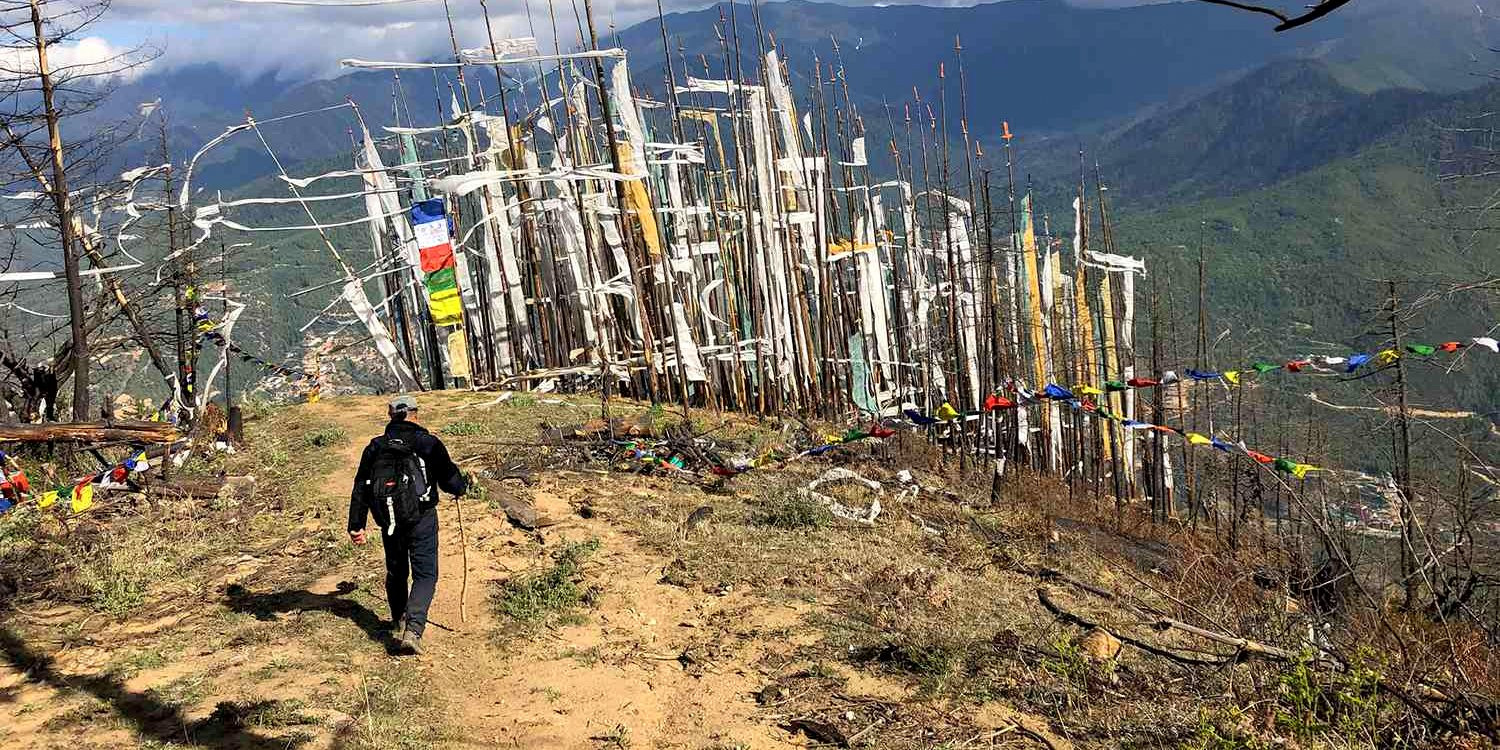Thimphu
Thimphu, the capital city of Bhutan, stands out for its unique blend of traditional Bhutanese culture and modernity, making it a fascinating destination for travelers. As the largest city in the country, Thimphu is the political, economic, and cultural centre of Bhutan, offering visitors a comprehensive glimpse into the nation's way of life. Here are some key attractions and experiences that make Thimphu a must-visit location:
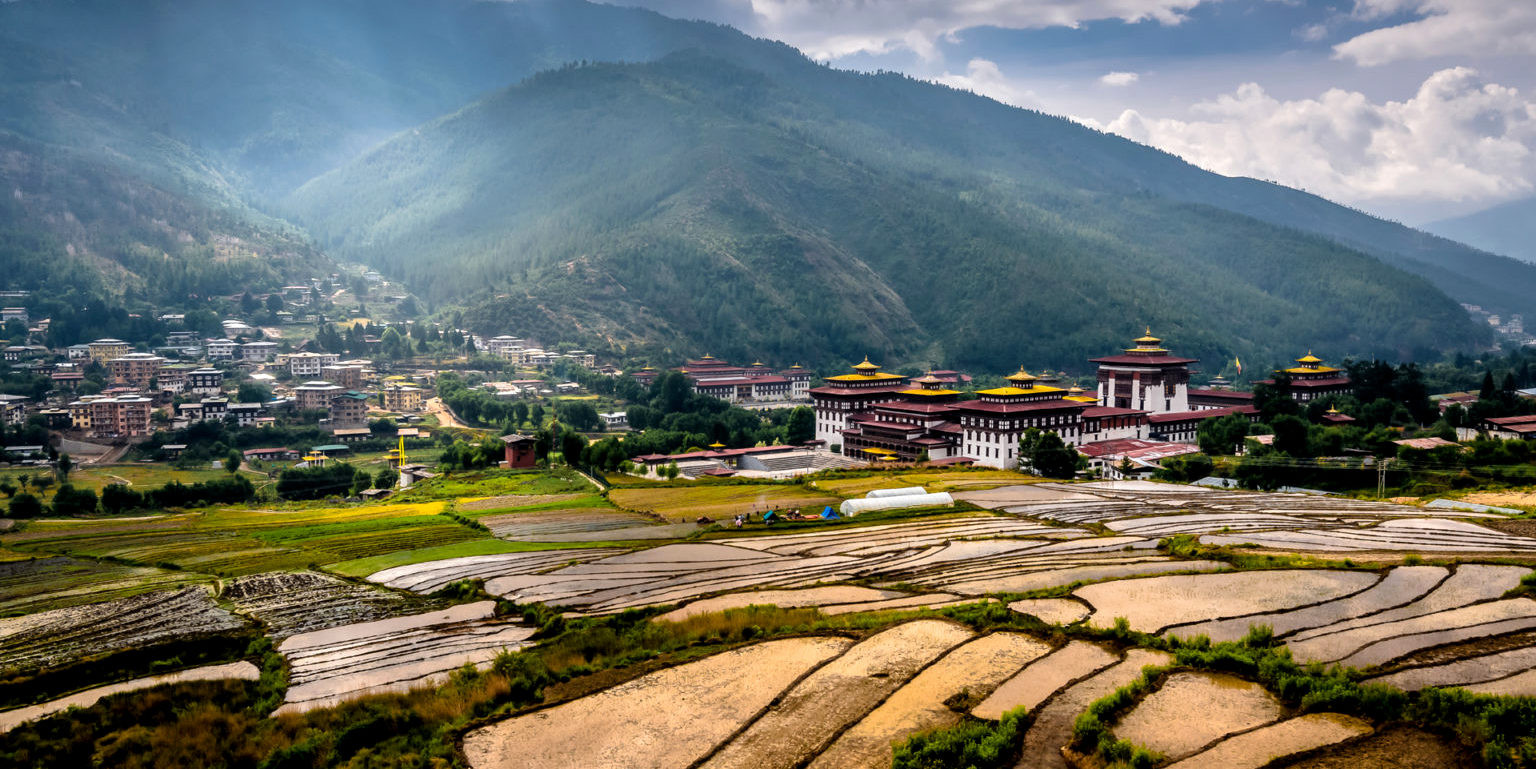
-
Tashichho Dzong: This impressive fortress and monastery serves as the seat of Bhutan's government and the king's office. It is a splendid example of Bhutanese architecture, with its whitewashed walls, golden roofs, and intricate woodwork. The dzong also houses the central monk body and is the venue for the city's most significant annual festival, the Thimphu Tshechu.
-
Buddha Dordenma Statue: Overlooking the Thimphu Valley from a hilltop, this gigantic, 51-meter-tall statue of Buddha is one of the largest in the world. Made of bronze and gilded in gold, it symbolises peace and prosperity. It also houses thousands of smaller Buddha statues, each of which, like the main statue, is made of bronze and gilded in gold.
-
National Memorial Chorten: This prominent landmark in Thimphu was built in memory of the Third King of Bhutan, His Majesty Jigme Dorji Wangchuck. The Chorten is a focus for daily religious offerings and prayers, adorned with richly painted annexes facing the cardinal directions and intricate mandalas.
-
Folk Heritage Museum (Phelchey Toenkhyim): Dedicated to connecting people to the Bhutanese rural past through exhibits, demonstrations, educational programs, and documentation, the Folk Heritage Museum offers a glimpse into traditional Bhutanese life. It is set in a traditional three-story, rammed-earth house, providing insights into the country's rural history, culture, and traditions.
-
Motithang Takin Preserve: Home to the takin, the national animal of Bhutan, this wildlife reserve area was originally a zoo but was converted into a preserve. The takin is a unique animal with the body of a cow and the head of a goat, and seeing it is a highlight for many visitors to Thimphu.
-
National Textile Museum: This museum showcases Bhutan's rich tradition of weaving, displaying a variety of textiles that are significant to Bhutanese culture. It offers insight into the techniques, styles, and importance of textiles in Bhutanese life.
-
Thimphu's Markets and Handicraft Shops: The Centenary Farmer's Market and various handicraft shops around Thimphu offer a colorful glimpse into Bhutanese daily life and are perfect for picking up souvenirs. From fresh produce to traditional Bhutanese arts and crafts, visitors can find a wide array of items that reflect the country's rich cultural heritage.
Thimphu is a city where the ancient and the modern coexist harmoniously. Its serene environment, coupled with the warmth of its people, makes it a welcoming place for visitors to discover the essence of Bhutanese culture and spirituality. Whether you're exploring its historic sites, enjoying the natural beauty, or engaging with the local traditions, Thimphu offers a memorable experience that captures the heart of Bhutan.
Paro
Paro, nestled in the heart of Bhutan, is a captivating valley town renowned for its verdant landscapes, historic buildings, and the iconic Taktsang Monastery, more commonly known as Tiger's Nest Monastery. As one of Bhutan's most important and mesmerizing destinations, Paro encapsulates the essence of Bhutanese culture, heritage, and natural beauty. Here's what makes Paro an unmissable stop on any journey through Bhutan:
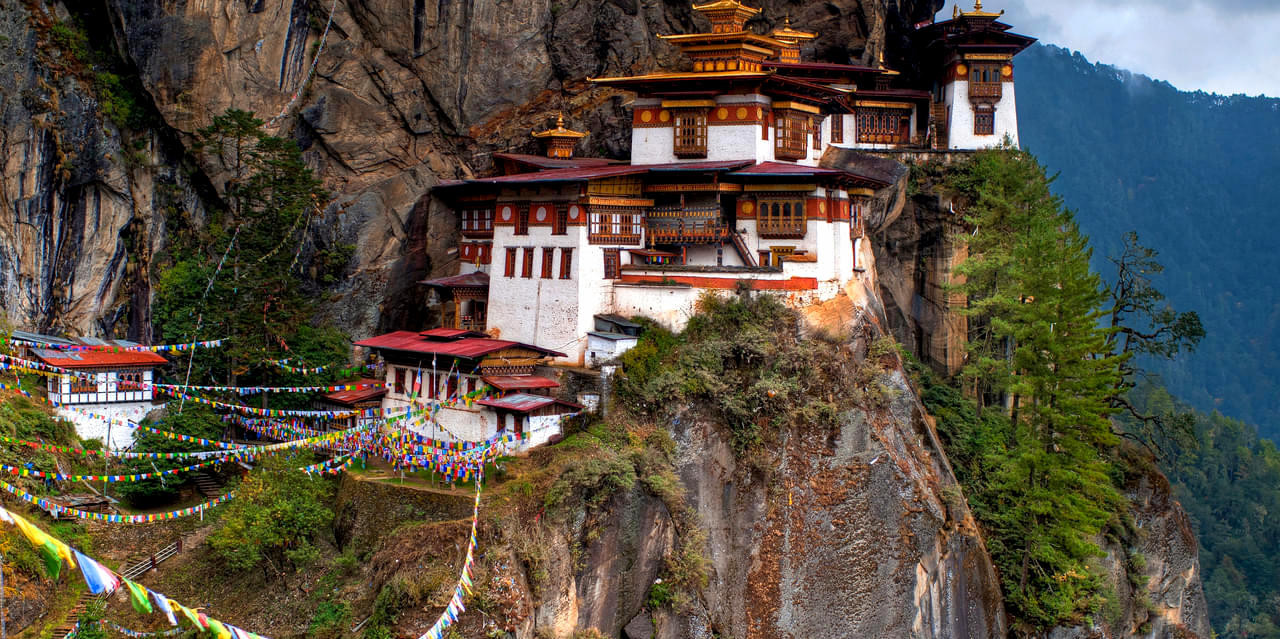
-
Taktsang Monastery (Tiger's Nest): Perched precariously on the side of a cliff about 900 metres above the Paro Valley, the Taktsang Monastery is perhaps the most photographed and famous site in Bhutan. Legend has it that Guru Rinpoche (Padmasambhava) flew to this location on the back of a tigress to subdue a local demon, meditated here for three months, and thus Buddhism took root in Bhutan. The hike to the monastery offers breathtaking views and a spiritual experience that is unparalleled.
-
Rinpung Dzong: Known as the "Fortress on a Heap of Jewels," Rinpung Dzong is a fine example of Bhutanese architecture and one of the most important dzongs in Bhutan. It serves both as a monastic home and as the administrative centre of the Paro district. With intricate woodwork and spiritual murals, the dzong is a testament to Bhutanese craftsmanship and religious devotion.
-
National Museum of Bhutan: Housed in a renovated ancient watchtower called Ta Dzong, the National Museum of Bhutan is a treasure trove of Bhutanese art, culture, and history. The circular structure of the building adds a unique architectural element, while its exhibits, which include ancient textiles, Thangka paintings, armaments, and a range of traditional artefacts, provide insights into Bhutan's rich cultural heritage.
-
Kyichu Lhakhang: One of the oldest and most sacred temples in Bhutan, Kyichu Lhakhang, dates back to the 7th century. It is said to be one of 108 temples built by Tibetan King Songtsen Gampo in a single day to subdue a demon lying across the Himalayas. The temple is a serene place of worship and attracts pilgrims and tourists alike.
-
Drukgyel Dzong: Though now in ruins, Drukgyel Dzong is a historic fortress that once played a crucial role in protecting Paro Valley from Tibetan invasions. Located at the north end of the valley, its remains offer a glimpse into the past and provide a dramatic backdrop against the snow-capped mountains, including Mount Jomolhari, which is considered sacred in Bhutan.
-
Paro's Traditional Architecture: Strolling through Paro town, visitors can admire the traditional Bhutanese architecture that characterises the region. The wooden facades, colourful paintings, and intricately designed windows of the buildings reflect the deep cultural reverence Bhutanese people have for their environment and traditions.
-
Local Markets and Handicrafts: Paro's local market and handicraft shops are vibrant places to explore Bhutanese crafts, textiles, and souvenirs. From hand-woven fabrics to traditional jewellery and wooden bowls, these markets offer a glimpse into the artistic skills and traditions of the local artisans.
Paro is not just a destination; it's an experience that embodies the spiritual, cultural, and natural wonders of Bhutan. Whether you're trekking to the Tiger's Nest, exploring ancient dzongs, or simply soaking in the tranquil beauty of the valley, Paro promises memories that will last a lifetime.
Punakha
Punakha, with its serene and sublime landscape, holds a special place in the heart of Bhutan. This historic town was the ancient capital of Bhutan and continues to be the winter home of the Je Khenpo, the Chief Abbot of Bhutan, along with the central monk body. Nestled at a lower elevation than most other parts of Bhutan, Punakha enjoys a milder climate, making it a fertile valley for agriculture. Here are the key highlights that make Punakha a must-visit destination:
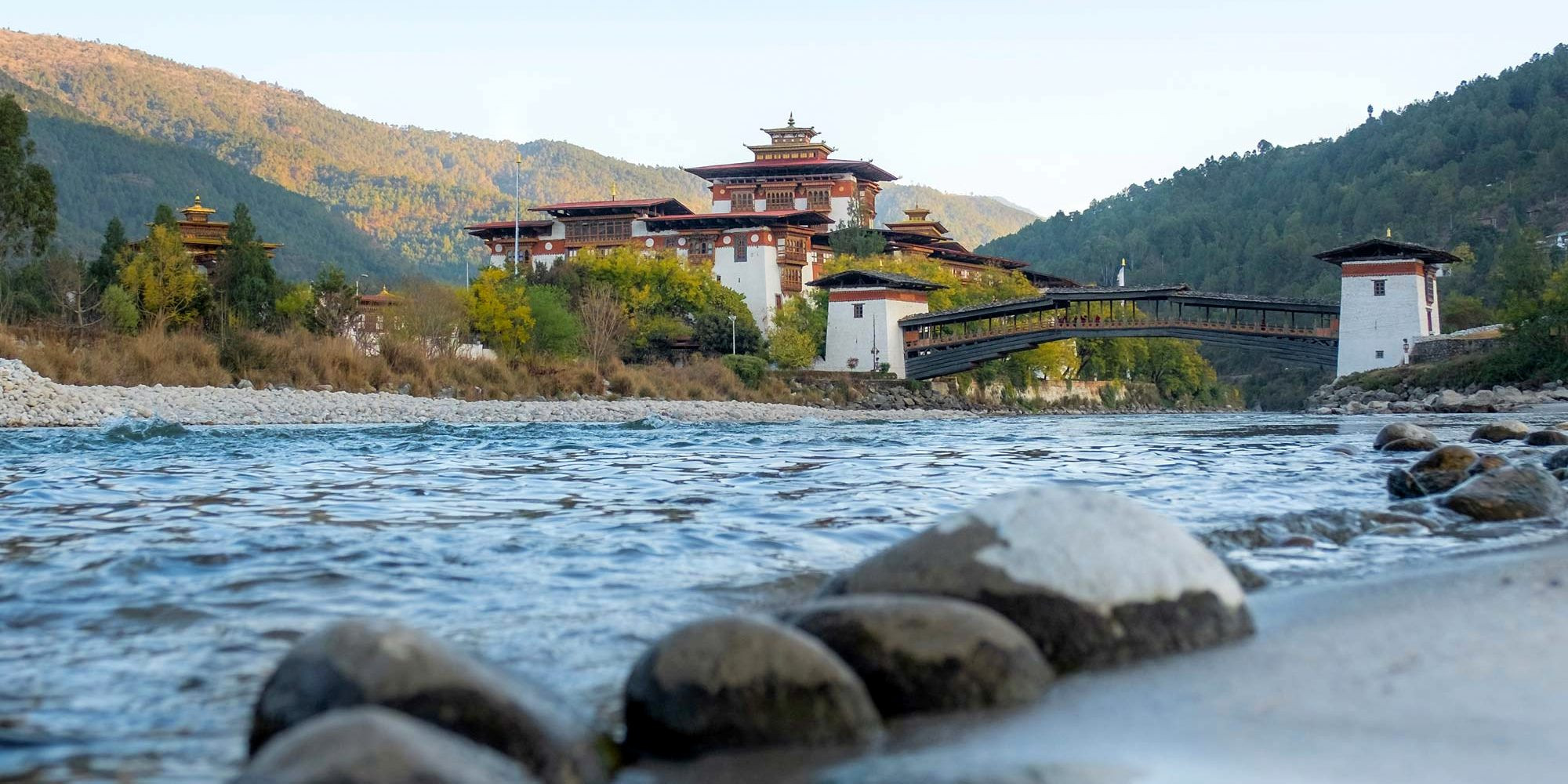
-
Punakha Dzong: Punakha Dzong, also known as Pungtang Dechen Photrang Dzong (meaning "the palace of great happiness or bliss"), is arguably the most beautiful dzong in the country. Strategically located at the confluence of the Pho Chhu (Father River) and Mo Chhu (Mother River), its majestic structure is a stunning example of Bhutanese architecture with its elaborate woodwork and intricate paintings. This dzong is not only a critical administrative and religious center but also the site of the King of Bhutan's historic wedding in 2011.
-
Suspension Bridge: Near the Punakha Dzong, the Punakha Suspension Bridge is one of the longest in Bhutan, stretching across the Po Chhu River. This bridge offers breathtaking views of the river and valley below, providing a thrilling experience as you walk across it. The bridge is also a path to numerous hiking trails in the surrounding hills, making it a favourite spot for nature lovers and trekkers.
-
Chimi Lhakhang: Fondly known as the Fertility Temple, Chimi Lhakhang is dedicated to Lama Drukpa Kunley, also known as the Divine Madman, for his unorthodox ways of teaching Buddhism using songs, humour, and outrageous behaviour. The temple is popular among couples and individuals praying for children, where it is believed that blessings from a wooden phallus can help them conceive.
-
Khamsum Yulley Namgyal Chorten: A relatively recent addition, the Khamsum Yulley Namgyal Chorten stands majestically on a ridge above the Punakha valley. Built by the Queen Mother for the peace and stability of the world, this chorten is unique in its architecture and internal design, which follow the strict guidelines of traditional Buddhist cosmology. The hike to the chorten through rice fields and pine forests is as rewarding as the panoramic views of the valley from the top.
-
River Rafting: For the adventurous, Punakha offers thrilling white-water rafting and kayaking opportunities on the Pho Chhu and Mo Chhu rivers. The rivers wind through the valley, offering a unique perspective of the dzongs, temples, and natural beauty of the area, all while providing an exhilarating experience for rafters of all skill levels.
-
Mo Chhu Nunnery: The Mo Chhu Nunnery, or the Sangchhen Dorji Lhuendrup Lhakhang Nunnery, is a serene retreat that houses a statue of Avalokiteshvara (the embodiment of compassion) and offers stunning views of the Punakha and Wangdue valleys. It is a place of study and meditation for Buddhist nuns and adds to the spiritual atmosphere of Punakha.
Punakha's rich history, stunning landscapes, and vibrant culture make it an essential part of any visit to Bhutan. Its warm climate, fertile lands, and the welcoming nature of its people provide a peaceful and enriching experience for all who venture here. Whether exploring its historic dzongs, enjoying the natural beauty, or engaging in adventurous activities, Punakha captures the essence of Bhutan's spiritual and natural harmony.
Trongsa
Trongsa, situated in the heart of Bhutan, plays a pivotal role in the kingdom's history due to its strategic location. This town is a vital bridge between the east and west of the country, with a landscape characterised by steep mountains and deep valleys. Trongsa is renowned for its impressive dzong, which historically served as a crucial seat of power over the central and eastern regions. Today, Trongsa is a must-visit for those interested in Bhutanese history and architecture, offering a deep dive into the country's rich cultural heritage.
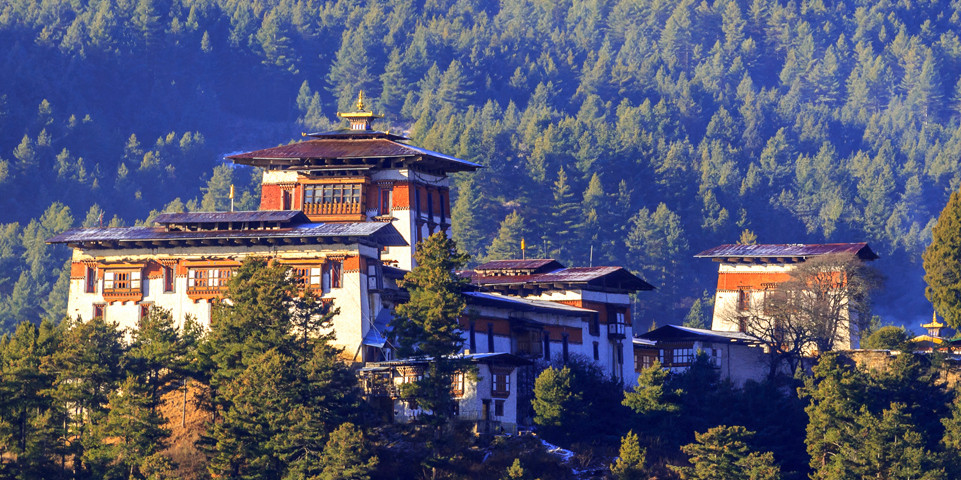
-
Trongsa Dzong: The Trongsa Dzong, or Chökhor Rabtentse Dzong, is the largest dzong fortress in Bhutan, majestically perched atop a ridge overlooking the Mangde Chhu river valley. Its strategic position allowed it to control the trade between the east and west of Bhutan. The architecture of Trongsa Dzong is a stunning example of Bhutanese craftsmanship, featuring intricate woodwork, beautiful courtyards, and a series of labyrinthine corridors and temples. It is also the ancestral home of Bhutan's royal family, with the first two kings of Bhutan ruling the country from this dzong.
-
Ta Dzong Museum: Above the Trongsa Dzong, the Ta Dzong, an ancient watchtower, has been transformed into a museum dedicated to the Wangchuck dynasty, which currently rules Bhutan. The museum houses a fascinating collection of artefacts, royal memorabilia, and Bhutanese art, offering insights into the country's monarchical history and cultural heritage. The museum also provides panoramic views of the surrounding valley and the dzong below, making it a perfect spot for photography enthusiasts.
-
Thruepang Palace: The Thruepang Palace is the birthplace of the third king of Bhutan, King Jigme Dorji Wangchuck. Although it is not as commonly visited as other sites, it holds historical significance and offers a glimpse into the royal lineage and history of Bhutan. The palace is a modest structure compared to the grandeur of Bhutan's dzongs but is an essential part of the Trongsa historical narrative.
-
Chendebji Chorten: Located a short distance from Trongsa, the Chendebji Chorten is a large Buddhist stupa that was constructed in the 18th century by Lama Shida in the style of the great Boudhanath Stupa of Nepal. It was built to subdue a demon that had been terrorising the inhabitants of the valley. The chorten is a serene spot for contemplation and offers a peaceful break for travellers heading to or from Trongsa.
-
The Royal Heritage Museum: Within Trongsa, the Royal Heritage Museum is another site that chronicles the lineage and life of Bhutan's monarchy. Housed in the ancient watchtower of Trongsa Dzong, it complements the Ta Dzong Museum, focusing on the cultural and historical aspects of Bhutanese governance and royal traditions.
Trongsa's central location and historical significance make it a key destination for understanding Bhutan's past and present. Its majestic dzong, fascinating museums, and historical sites offer a comprehensive look at the architectural, cultural, and political heritage of Bhutan. For anyone interested in delving deeper into the heart of Bhutanese culture and history, Trongsa provides a captivating and educational experience.
Bumthang
Bumthang, often referred to as the spiritual heartland of Bhutan, is a region that encompasses four major valleys: Chokhor, Tang, Ura, and Chhume. This area is revered for its sacred sites, ancient temples, and monasteries, making it a focal point for pilgrimages and a haven for those seeking spiritual solace. With its lush valleys, serene landscapes, and rich history, Bumthang offers a deeper insight into Bhutan's spiritual essence and cultural heritage.
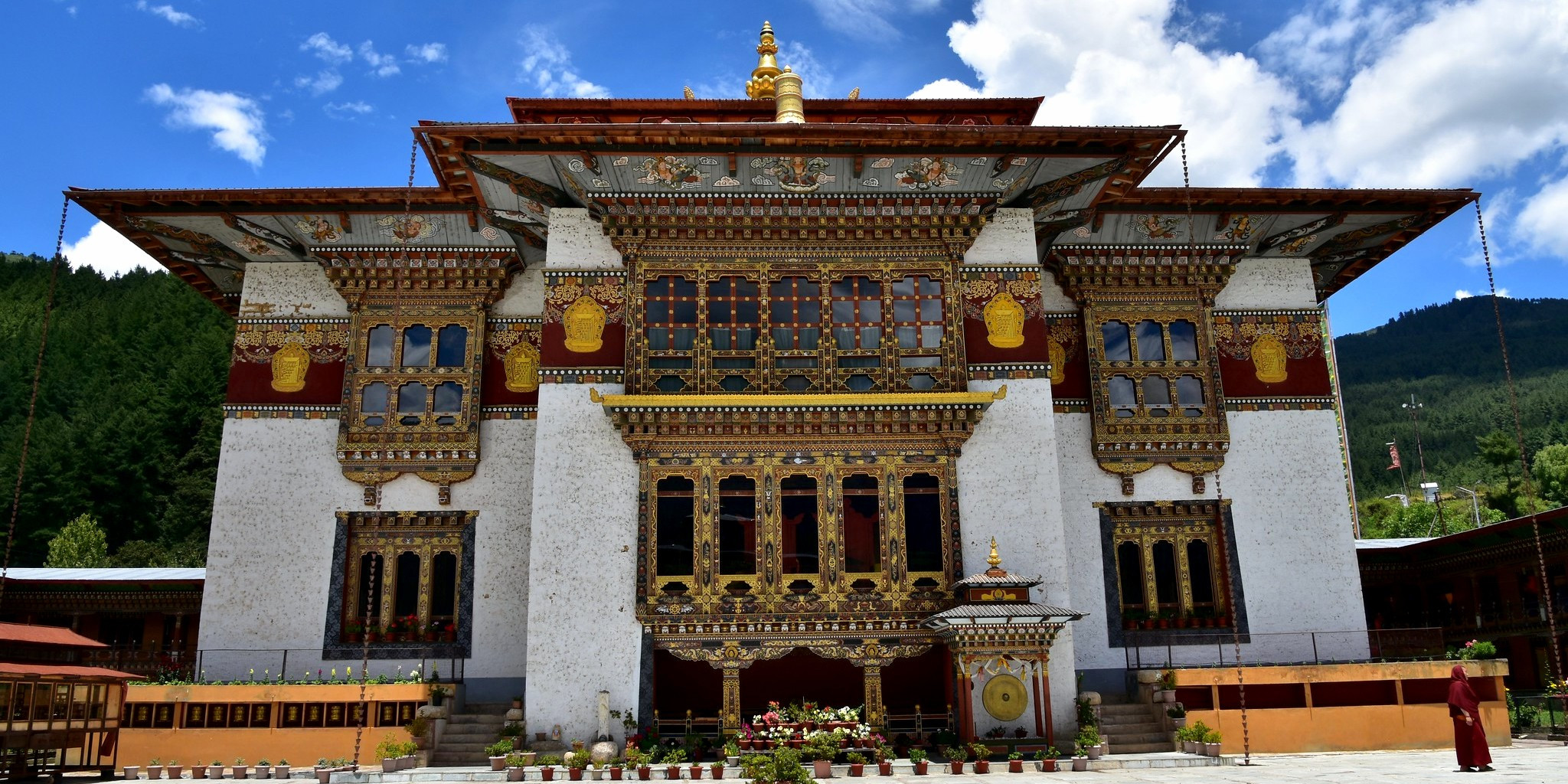
-
Jakar Dzong: The Jakar Dzong, or "Castle of the White Bird," presides over the Chokhor Valley with commanding views. Legend has it that a white bird signalled the location for the construction of this fortress in the 16th century. Today, it serves as the administrative centre and monastic complex for Bumthang district, embodying Bhutanese architectural prowess with its massive walls and beautifully intricate internal courtyards.
-
Jambay Lhakhang: Jambay Lhakhang, one of the oldest temples in Bhutan, was purportedly built in the 7th century by the Tibetan King Songtsen Gampo as part of his mission to construct 108 temples to subdue a demon across the Himalayas. The temple is renowned for its sacred statues and artworks, as well as the Jambay Lhakhang Drup festival, which features the unique fire ceremony and the Tercham (Naked Dance), intended to bless and protect the community.
-
Kurjey Lhakhang: The Kurjey Lhakhang complex is one of the most sacred sites in Bhutan, as it is said to be where Guru Rinpoche (Padmasambhava) left his body imprint on a rock while meditating. The complex consists of three temples surrounded by 108 chorten walls, symbolising each of the 108 temples built by Songtsen Gampo. The serene atmosphere and profound spiritual significance make it a must-visit for those exploring Bhutan's religious heritage.
-
Tamshing Lhakhang: Founded in the 16th century by Pema Lingpa, one of the most important tertons (treasure discoverers) in Bhutanese history, Tamshing Lhakhang houses some of the oldest and most precious religious paintings in Bhutan. The temple is also known for its annual Tamshing Phala Chhoepa festival, which draws devotees from across the region.
-
Mebar Tsho (The Burning Lake): Mebar Tsho, or the Burning Lake, is a sacred site located in the Tang Valley. It is where Pema Lingpa discovered several of Guru Rinpoche's hidden treasures in the 15th century. The lake is surrounded by steep cliffs and dense forests, offering a picturesque and tranquil setting for meditation and reflection.
-
Ura Valley: The Ura Valley, with its cobblestone streets and closely set mediaeval houses, provides a glimpse into the traditional Bhutanese way of life. The annual Ura Yakchoe festival, which takes place in the Ura Lhakhang, is a vibrant display of local customs, dances, and the revered display of a sacred relic.
Bumthang's blend of natural beauty and spiritual depth makes it a unique region within Bhutan. Visitors are not only treated to breathtaking landscapes and architectural marvels but are also invited to partake in a centuries-old spiritual tradition that continues to thrive. Whether it's exploring ancient temples, participating in local festivals, or simply soaking in the serene atmosphere, Bumthang offers an enriching experience that touches the soul.
Tips for Best places to Visit in Bhutan
Visiting Bhutan, a country known for its majestic natural beauty and profound spiritual heritage, is a once-in-a-lifetime experience. To make the most of your journey through this Himalayan kingdom, here are some essential tips for exploring the best places in Bhutan:
-
Plan According to the Season: Off-Peak Travel: Visiting during the off-peak season (December to February and June to August) can be rewarding with fewer tourists and unique experiences, such as witnessing the rare black-necked cranes in Phobjikha Valley during winter.
-
Attend Traditional Festivals: Bhutanese festivals, or Tshechus, are a spectacle of culture, colour, and dance. Plan your visit around these festivals to experience Bhutanese traditions firsthand. Notable festivals include Paro Tshechu, Thimphu Tshechu, and Punakha Drubchen.
-
Respect Local Customs and Traditions: Bhutanese culture is deeply rooted in Buddhism and tradition. Dress modestly, especially when visiting religious sites, and always ask permission before taking photographs of people or religious objects.
-
Acquire the Right Permits: Special Permits: For certain areas outside the standard tourist routes, such as Bumthang or beyond, special area permits are required. Your tour operator can arrange these.
-
Embrace the Local Cuisine: Bhutanese cuisine is known for its simplicity and heat. Don't miss trying Ema Datshi (chilli and cheese), red rice, and momos. Be cautious with the chilli if you're not accustomed to spicy food.
-
Engage with Sustainable Tourism Practices: Bhutan is a global leader in sustainable tourism. Engage with local communities, support local artisans by purchasing handmade goods, and be mindful of your environmental impact.
-
Explore Beyond the Tourist Trail: While popular destinations like Paro, Thimphu, and Punakha are must-visits, don't hesitate to explore less-visited regions like Haa Valley, Phobjikha Valley, or the remote villages in the east for a more authentic experience.
-
Prepare for Altitude: Many of Bhutan’s attractions are at high elevations. Acclimatise properly to avoid altitude sickness, especially if you plan to trek or visit places like Tiger’s Nest Monastery.
-
Choose the Right Accommodation: Bhutan offers a range of accommodations, from luxurious hotels to cosy homestays. Consider staying in traditional Bhutanese guesthouses for a more immersive experience.
-
Be Prepared for the Roads: Travelling between destinations in Bhutan can take longer than expected due to the mountainous terrain. Enjoy the journey and the stunning landscapes along the way.
-
Connect with Nature and Spirituality: Bhutan's pristine environment and spiritual sites offer a unique opportunity for reflection and connection. Take time to meditate or simply soak in the tranquilly of the surroundings.
By following these tips, your visit to Bhutan will not only be enjoyable but also respectful and enriching, allowing you to fully experience the beauty and depth of this extraordinary country.
Health and Safety for Best places to Visit in Bhutan
Traveling to Bhutan, a country known for its serene landscapes and spiritual ambiance, is a wonderful experience. However, ensuring a safe and healthy trip requires preparation and awareness of the local conditions. Here are some health and safety tips for visiting Bhutan:
Health Considerations
-
Altitude Sickness: Bhutan's high altitude can pose risks of altitude sickness, especially in places like Thimphu, Paro, and trekking routes. Acclimatize gradually, stay hydrated, and consider bringing altitude sickness medication.
-
Vaccinations: Before travelling, consult with a travel clinic or your healthcare provider for recommended vaccinations. Routine vaccines such as influenza, tetanus, and measles, as well as travel vaccines for hepatitis A and typhoid, are often suggested.
-
Medical Facilities: While basic medical services are available in major cities, they may not meet Western standards, especially in rural areas. Travellers with specific health conditions should carry sufficient medication for the entire trip and consider travel insurance that covers medical evacuation.
-
Food and Water Safety: Stick to bottled or purified water and avoid raw or undercooked food to prevent gastrointestinal illnesses. Bhutanese cuisine is generally safe and delicious, but it's wise to eat at reputable restaurants or hotels.
-
Insect Bites: While Bhutan is not known for severe mosquito-borne diseases, it's still advisable to use insect repellent and wear long sleeves and pants during dawn and dusk to prevent bites.
Safety Considerations
-
Travel Insurance: Opt for comprehensive travel insurance that covers medical treatment, evacuation, and trip cancellations or interruptions.
-
Road Safety: Road conditions in Bhutan can be challenging, with winding, mountainous roads prone to closures due to landslides or weather conditions. Always use seatbelts, avoid nighttime travel, and consider hiring a local driver familiar with the terrain.
-
Respect Local Customs: Bhutanese society values respect and modesty. Dress appropriately, especially when visiting religious sites, and always ask permission before taking photographs of people or religious ceremonies.
-
Guided Tours: Since all international tourists (except nationals from India, Bangladesh, and the Maldives) must travel on a pre-arranged itinerary with a licenced Bhutanese tour operator, you'll likely have a guide. Listen to your guide's advice, especially regarding local customs, safety, and when trekking or visiting remote areas.
-
Natural Hazards: Be aware of potential natural hazards, such as earthquakes and sudden weather changes, that could lead to flash floods or landslides, especially if you're trekking or visiting remote areas. Follow local advice and your guide's instructions.
-
Emergency Services: Familiarise yourself with emergency contact numbers in Bhutan. The universal emergency number for police is 113; for ambulances, 112; and for the fire service, 110.
By preparing adequately and respecting local customs and advice, your visit to Bhutan can be a safe, healthy, and enriching experience, allowing you to fully enjoy the tranquilly and beauty of this unique Himalayan kingdom.
Best Time for Best Places to Visit in Bhutan
The best time to visit Bhutan largely depends on what you want to experience in this Himalayan kingdom, as the country offers distinct experiences across different seasons. However, the most popular times to visit are during the spring and autumn months, when the weather is favourable and the country's landscapes are particularly vibrant.
Spring (March to May)
-
Weather: The weather is pleasant, with mild temperatures and clear skies, ideal for outdoor activities and trekking.
-
Natural Beauty: The valleys are lush and green, and the famous rhododendrons, along with other flowers, are in full bloom, making it a great time for photography.
-
Festivals: Spring is also the season for some of the most colourful and vibrant festivals in Bhutan, including the Paro Tshechu, which attracts both locals and tourists.
Autumn (September to November)
-
Weather: This season offers clear skies and cool temperatures, perfect for trekking and exploring the countryside.
-
Festivals: Major festivals like the Thimphu Tshechu and the Jakar Tshechu occur during autumn, providing a glimpse into Bhutanese culture and tradition through masked dances and religious performances.
-
Scenery: The landscape transforms into a vivid palette of golds, oranges, and reds, especially in the higher altitudes, making it a spectacular backdrop for travel.
Summer (June to August)
-
Rainfall: While heavy rains can lead to travel disruptions, they also bring out the lushness of Bhutan’s forests and countryside.
-
Lower Tourist Numbers: If you prefer solitude and are interested in experiencing Bhutan's natural beauty without the crowds, this could be the time to visit.
-
Pricing: Some services and accommodations may offer off-peak rates during this time.
Winter (December to February)
-
Snowfall: The higher regions and mountains are covered in snow, offering breathtaking landscapes.
-
Bird Watching: The Punakha Valley and Phobjikha Valley are great for bird watching, including the rare black-necked cranes.
-
Fewer Tourists: With fewer tourists, winter can be a peaceful time to explore Bhutan’s cultural sites.
Considerations
-
High-Altitude Locations: For trekking in high-altitude areas, spring and autumn provide the best conditions.
-
Cultural Experiences: If your primary interest is in festivals and cultural experiences, align your visit with the festival calendar.
-
Personal Preferences: Consider what you value most—whether it's pleasant weather, cultural immersion, or the tranquilly of off-peak travel—when planning your trip.
No matter when you choose to visit, Bhutan offers a rich tapestry of experiences, with each season bringing its own unique flavour and opportunities for exploration.
Bhutan, the Land of the Thunder Dragon, captivates visitors with its pristine natural beauty, deep spiritual heritage, and rich cultural traditions. From the iconic Tiger's Nest Monastery in Paro to the historic fortresses of Punakha, each destination offers a unique glimpse into the kingdom's soul. The serene valleys of Bumthang and the architectural marvels of Thimphu further enrich the traveler's experience, inviting a journey that transcends the ordinary. Ideal visit times are spring and autumn, when the country's natural splendour and cultural vibrancy come to life through festivals and clear weather. Bhutan's commitment to sustainability and happiness makes every visit a profound encounter with a society living in harmony with its environment. This Himalayan kingdom is not just a place to see but an experience, offering a journey into tranquilly, beauty, and a deeper understanding of contentment.
FAQs for Best Places to Visit in Bhutan
Q. What is the best time to visit Bhutan?
A. The best time to visit Bhutan is during spring (March to May) and autumn (September to November), when the weather is clear and pleasant and the country hosts vibrant festivals. These seasons offer the best conditions for trekking, sightseeing, and attending cultural events.
Q. Do I need a visa to visit Bhutan?
A. Yes, all foreign nationals, except for citizens of India, Bangladesh, and the Maldives, need a visa to visit Bhutan. Visas must be arranged through a registered Bhutanese tour operator prior to arrival and cannot be obtained upon entry.
Q. How can I get to Bhutan?
A. Bhutan can be accessed by air through Paro International Airport, which is well connected with flights from major cities like Bangkok, Delhi, Kolkata, and Kathmandu. Overland entry is also possible through the border towns of Phuentsholing, Gelephu, and Samdrup Jongkhar for travellers coming from India.
Q. What are the must-visit places in Bhutan?
A. Must-visit places in Bhutan include the Tiger's Nest Monastery in Paro, Punakha Dzong in Punakha, Tashichho Dzong in Thimphu, and the sacred valleys of Bumthang. Each location offers a unique insight into Bhutan's cultural and spiritual heritage.
Q. Is Bhutan expensive to visit?
A. Bhutan has a unique tourism policy that requires all tourists (except Indian, Bangladeshi, and Maldivian nationals) to pay a minimum daily package rate. This rate covers accommodation, meals, a licenced Bhutanese guide, and transport within the country, making Bhutan appear more expensive compared to other destinations. However, this policy ensures a high-quality, sustainable travel experience.
Q. What should I pack for Bhutan?
A. Pack layers to accommodate varying temperatures, especially if you're travelling through different altitudes. Include warm clothing, a waterproof jacket, comfortable walking shoes, and essentials like sunscreen, a hat, and sunglasses. Don't forget to bring any necessary medications, as well as a universal travel adapter for your electronics.
Q. Can I use my cell phone in Bhutan?
A. Yes, you can use your cell phone in Bhutan, but it's advisable to purchase a local SIM card for better coverage and rates. Ensure your phone is unlocked before your trip to use a Bhutanese SIM card.
Q. What is the currency in Bhutan and are credit cards accepted?
A. The currency in Bhutan is the Ngultrum (BTN). Credit cards are increasingly accepted in hotels, restaurants, and some shops, especially in larger towns and tourist areas. However, carrying cash is recommended for small purchases and in remote areas.
Q. What are the main festivals in Bhutan?
A. Bhutan's main festivals, or Tshechus, include Paro Tshechu, Thimphu Tshechu, and Punakha Drubchen. These festivals feature masked dances, religious rituals, and cultural exhibitions, offering deep insights into Bhutanese tradition and spirituality.
Q. Is it safe to travel to Bhutan?
A. Bhutan is considered one of the safest travel destinations, with low crime rates and a welcoming populace. However, travellers should always take standard safety precautions, particularly when trekking or travelling in remote areas.
For the Nepal tour, please click here.
If you are looking for different kinds of Nepal Tours or Trekking Packages, feel free to contact us.
